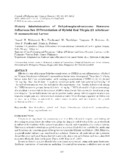Possible application of mibolerone for induced sex inversion of grouper Epinephelus coioides
Share
Abstract
Thirty immature juvenile grouper Epinephelus coioides (19-168 g bodyweight, BW) were randomly stocked in four units 6 t tanks to determine if mibolerone can be used to induce sex inversion in groupers. After acclimatization and weaning to artificial feed, the feed given daily (4% BW/day) was supplemented with 0, 50, 100, and 200 μg mibolerone/kg feed for about 18 weeks. Thereafter, the hormone treatment was withdrawn and the experiment was terminated at Week 24. Ten fish were killed for gonad histology at stocking to serve as an initial control while about three to five fish were killed every 8 weeks. In general, ovaries of initial controls showed the presence of moderate stromal cells and gonia and few primary oocytes. At Weeks 8 and 16, ovaries of the control fish (0 μg/kg) were similar to that of the initial control except that primary oocytes increased at Week 24. Gonads of fish fed diets containing 100 and 200 μg/kg had none to moderate spermatocytes and few spermatids at Week 8 and 16, although spermatozoa were not observed, indicating that the fish were undergoing spermatogenesis. Spermatogenesis at 50 μg/kg was not as advanced since only few spermatocytes occurred at Weeks 8 followed by moderate gonia and no spermatocytes and spermatids at Week 16. However, the presence of few primary oocytes was observed when mibolerone was withdrawn suggesting that sex-inversed fish reverted back to a female condition. These results show that sex inversion in juvenile grouper can be induced by oral administration of mibolerone and may have possible application on mature females to produce functional males.
Suggested Citation
Quinitio, G. F., Tan-Fermin, J. D., & Nagai, A. (2001). Possible application of mibolerone for induced sex inversion of grouper Epinephelus coioides. Fisheries Science , 67(2), 232-237. https://doi.org/10.1046/j.1444-2906.2001.00245.x
Subject
Collections
- AQD Journal Articles [1249]
Related items
Showing items related by title, author, creator and subject.
-
How to operate tilapia hatcheries
Surtida, Marilyn B. (Aquaculture Department, Southeast Asian Fisheries Development Center, 1998) -
Induction of sex inversion in juvenile grouper, Epinephelus suillus, (Valenciennes) by injections of 17α-Methyltestosterone
Tan-Fermin, Josefa D.; Garcia, Luis Maria; Castillo, Antonio R., Jr. (The Ichthyological Society of Japan, 1994)Four groups of two-year old juvenile groupers (Epinephelus suillus), each with 8-9 individuals of mean body weight (BW) 1.2 kg, were treated with 17α-methyltestosterone (MT). MT was injected intramuscularly within the range ... -
Dietary administration of dehydroepiandrosterone hormone influences sex differentiation of hybrid red tilapia (O. niloticus x O. mossambicus) larvae
Mohamed, Asaad H.; Traifalgar, Rex Ferdinand M.; Serrano, Augusto E., Jr.; Peralta, Jose P.; Pedroso, Fiona L. (Academic Journals, New York, 2012)Effects of a steroid hormone Dehydroepiandrosterone (DHEA) on sex differentiation of hybrid red Tilapia Oreochromis niloticus x O. mossambicus larvae were investigated. Three day-old tilapia larvae were fed diets supplemented ...




